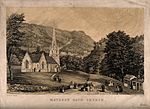Masson Mill
Cotton millsFormer textile mills in the United KingdomGrade II* listed buildings in DerbyshireGrade II* listed industrial buildingsHydroelectric power stations in England ... and 10 more
Industrial Revolution in EnglandIndustrial archaeological sites in EnglandIndustry museums in EnglandMuseums in DerbyshireSpinningTextile mills completed in the 18th centuryTextile mills in DerbyshireTextile museums in the United KingdomUse British English from February 2023Watermills in Derbyshire

Sir Richard Arkwright's Masson Mill is a water-powered cotton spinning mill situated on the west bank of the River Derwent in Matlock Bath, Derbyshire in England. This mill was built in 1783. It forms part of the Derwent Valley Mills, a World Heritage Site. Nearby is Willersley Castle, the house Richard Arkwright built for himself within the parish of Matlock.
Excerpt from the Wikipedia article Masson Mill (License: CC BY-SA 3.0, Authors, Images).Masson Mill
Derby Road, Derbyshire Dales
Geographical coordinates (GPS) Address Website Nearby Places Show on map
Geographical coordinates (GPS)
| Latitude | Longitude |
|---|---|
| N 53.1128 ° | E -1.5616 ° |
Address
Masson Mills Shopping Village
Derby Road
DE4 3PY Derbyshire Dales
England, United Kingdom
Open on Google Maps










